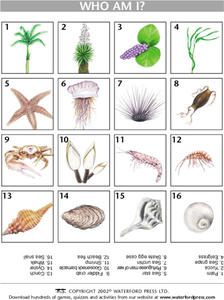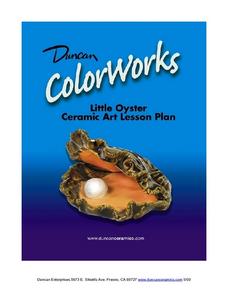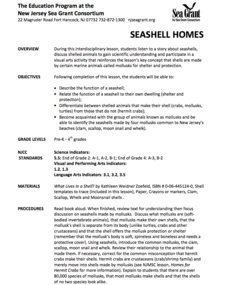K-State Research and Extensions
You Ol’ Fossil
Geologists are gneiss, tuff, and a little bit wacke. The fifth chapter of seven includes ten activities at four different levels. The hands-on activities cover fossils including how they are formed, vertebrates, invertebrates,...
Biology Junction
Mollusks
Mollusks created every shell on Earth. Young scientists learn more about the phyllum mollusca in an informative presentation. It covers their characteristics, body plans, and relationships in the ecosystem. Then, it details each class of...
Biology Junction
Invertebrates
How many different invertebrates can you name? A thorough presentation describes the eight different Phyla of invertebrates. Each slide gives a quick overview of the important physical characteristics of each of the Phyla.
Biology Junction
Dissection of the Clam
Is the structure of a clam really as simple as it seems? Young scholars explore the anatomy of the clam in an engaging lesson presentation. The lesson highlights the digestive process of the clam as well as how it moves and what it does...
Howard Hughes Medical Institute
Ocean Acidification
Human impacts on the environment can sometimes be difficult to measure, especially under water! An activity centered on ocean acidification gives science scholars the opportunity to examine the effects of carbon dioxide on marine life....
Curated OER
Who am I?
A colorful matching activity on sea life is here for your class. Learners must correctly place the name of the life form in the box where it is pictured. The pictures are colorful and accurate. This would be a good addition to any unit...
Curated OER
Who Am I?
Youngsters find these common sea plants and animals using a worksheet. Each of the plants and animals has a colorful representation on the worksheet. There is an answer key at the bottom of the worksheet that has all of plant and animals...
Curated OER
Who am I?
Here's a worksheet that has a variety of animals pictured. Learners must cut and paste the correct name and glue it in the box with the pictured animal. Great for young learners. An answer key is included on the worksheet.
Curated OER
Who am I?
This resource allows young botanists to see plants, sea life, and more. They must find the name of the organism and paste it underneath the picture. The pictures are especially colorful. This would be a great worksheet for...
Australian Geological Survey
Nautiloid Model
At a glance, this cut-out paper model of a nautiloid looks promising. Know, however, that it requires manual dexterity for cutting out neatly and for folding and attaching the tabs. This particular mollusk model is quite difficult to...
Curated OER
Parts of a Snail
Here is a simple, yet well-designed worksheet on the parts of a snail for your young biologists. Learners label the five parts of a snail using words that appear on the worksheet. Then, they circle the words on the bottom of the...
Curated OER
Octopus Project: Ceramics
Kids make an octopus out of clay. They practice their sculpting and modeling skills such as pinch pot and slurry technique while sculpting an octopus.
Curated OER
Little Oyster: Ceramic Lesson
Children will love researching and then creating a bottom dwelling mollusk of their own. They watch clips describing the ocean ecosystem and how oysters fit into their environment. Next, they research what oysters eat and how they look....
Curated OER
Mollusks
In this mollusks worksheet, learners color several figures and label them with the correct parts. They complete 14 short answer questions related to mollusks.
Curated OER
Mollusks
In this mollusks worksheet, students complete a word search for terms related to the different types of mollusks and their body structures.
Curated OER
Mollusks
In this mollusks worksheet, students complete a crossword puzzle given 15 clues about the structures of mollusks, the characteristics of mollusks and types of mollusks.
Curated OER
Slugs and Snails
Slugs and snails are the focus of this life science worksheet. Student read a selection on these animals, then answer ten comprehension questions. Then, students must draw an "alien portrait" using the characteristics of slugs and snails...
Curated OER
Digging Into Science Lesson Plans
In this biology worksheet, students identify and write the various species that are still present today. Then they define evolution using three words. Students also describe what a fossil is and give some examples related to a particular...
Curated OER
Life Has A History
In this biology worksheet, students identify and match various classes of species found today. Then they explain why biodiversity exists today on earth and define evolution. Students also describe who a paleontologist is and what they do.
Curated OER
Mollusk Matching
Students look carefully at shells and observe the differences between
species and the names of common shells. Then they identify and complete a Mollusk Matching handout included in the lesson and write the letter of each shell in the...
Curated OER
Dichotomous Keys
Students define the word dichotomous and explain why a dichotomous key is a useful tool in identifying different species. Then they look up words they are unfamiliar with or mollusk reference books so students can
learn the names of...
Curated OER
Seashell Homes
Pupils listen to a story about seashells. They discuss shelled animals. Learners describe the function of seashell. Pupils relate the function of a seashell to their own dwelling. They differentiate between shelled animals that make...
Curated OER
Under the Sea
Students identify and interpret that non-fiction books have features like a table of contents, a glossary, and an index, which can efficiently help them find information. They also identify how to narrow the search for information by...
Curated OER
The Mighty Hudson Stretches its Mussels
Young scholars brainstorm possible causes of zebra mussel migration and population expansion. They identify the key causes and effects of the disturbance of the Hudson River ecosystem and research causes and effects in the disturbances...

























